This August marked 10 years of the inauguration of the Sabarmati Riverfront project in Ahmedabad. The then Gujarat chief minister Narendra Modi became India’s Prime Minister two years later and the chief architect-planner of the riverfront project, Bimal Patel, went on to become the government’s preferred man for massive redevelopment projects including the Central Vista in New Delhi and the Kashi-Vishwanath Corridor in Modi’s parliamentary constituency.
The idea of riverfront development has travelled too as cities around India are proposing such projects for rivers that flow across their terrain. In this context, it is significant to revisit the Sabarmati riverfront development to take stock of what it has achieved in the past decade and whether it is a model worth emulating.
In a nutshell, the Sabarmati riverfront development is symbolic of how a natural river, not perennial but dependent on the monsoon, has been turned into an infrastructure project with emphasis on commercial and recreational aspects rather than on ecological conservation. Gujarat’s development paradigm – massive land acquisition for real estate, flashy commercial complexes with heat-generating glass facades, expanding physical infrastructure at the cost of natural areas – is encapsulated in the Sabarmati riverfront project.
The Sabarmati River originates in Rajasthan’s Aravalli Hills, meanders through areas in Gujarat, and meets the Arabian Sea in the Gulf of Khambhat having ebbed and flowed through nearly 371 kilometres. The Sabarmati riverfront project, on the other hand, is the 11.5-kilometre veritable tank with stagnant water filled from the canal of the Sardar Sarovar dam on the Narmada River; the canal crosses the Sabarmati a few kilometres upstream from Ahmedabad city.
This, then, is the tale of two Sabarmatis – one channelled and concretised to build physical infrastructure catering to a certain section in Ahmedabad while the other, the longer river itself, treated as drainage for effluents and pollutants. The former, glitzy and showcase-worthy, takes ecological and political attention away from the latter; yet, without the gurgling health of the river, the riverfront itself is of little use.
This was brought home starkly in early October: The triathlon, part of the 36th National Games inaugurated by Modi in Ahmedabad and scheduled in the scenic Sabarmati riverfront, had to be called off. The reason? The athletes could not swim in the water because the “green unhygienic polluted water” in the riverfront posed severe health hazards.
Sixty-two athletes were to compete for over 750 metres in open waters of the Sabarmati riverfront besides biking 20 kilometres and running 5 kilometres. The riverfront would have been the ideal location but due to the abysmal water quality, the venue was hurriedly shifted nearly 35 kilometres away to the Indian Institute of Technology (IIT) Gandhinagar campus, and the water events were held in a covered swimming pool.
If the water quality in this part of the river was so appalling, it should have generated a debate over the “achievements” of the riverfront project itself – and the lessons it holds for similar projects. It hardly made news compared especially to the happier events such as the kite festival and Modi hosting Chinese Premier Xi Jinping to showcase the riverfront. During the Gujarat Assembly polls in 2017, Modi had landed in the riverfront on a seaplane thrusting the riverfront project further into national consciousness.
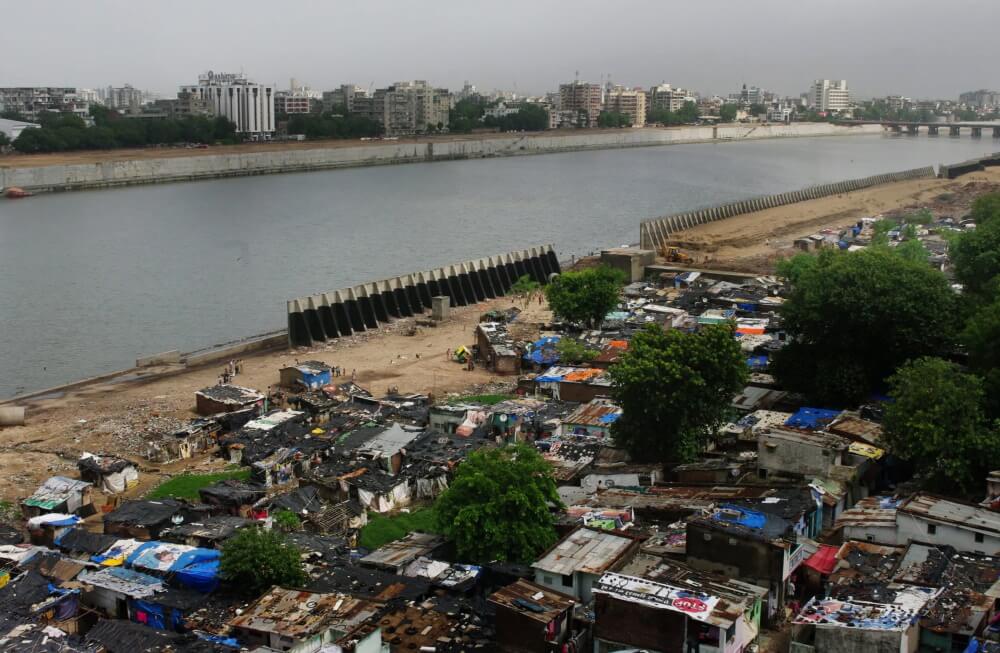
Photo credit: via Darshan Desai
The backstory of changing landscape
The Sabarmati riverfront project was first proposed in the 1960s by French architect Bernard Kohn, among others. Kohn, it is believed, wanted to make “an ecological valley” in the river basin but later distanced himself from the project. It picked up momentum in the 1990s when the Ahmedabad Municipal Corporation (AMC) set up the Sabarmati Riverfront Development Corporation Limited with the explicit purpose “to revivify the city centre by connecting it to the river.”
It charted out a nine- kilometre stretch from Subhash Bridge to Vasna Barrage with a total landfilling of 162 hectares of the riverbed. The feasibility report was prepared by an organisation with which Bimal Patel was associated. The riverfront plan went through iterations till 2005 when it was finalised as nearly 11-kilometre stretch with “development” – concretisation on both sides – and 190 hectares of landfilling. Eventually, the latter has gone beyond 200 hectares on which stand swanky infrastructure including parks and gardens, markets, recreation amenities and more.
When Ahmedabad was inundated in the August 2006 floods, the project had to be halted. Environmentalists and social activists had raised a number of concerns too – around the carrying capacity and re-engineering of the river width, and rehabilitation of thousands of people who were living and earning their livelihood on the natural banks. The Indian Institute of Technology (IIT) Roorkee and the National Institute of Hydrology were asked to re-evaluate the project design from the perspective of whether the riverfront development would damage the river’s ecology; their reports seemed to suggest so and they made at least two suggestions: one, a gauge to determine flood levels where the Narmada’s main canal crosses the Sabarmati; two, dredging upstream of the Vasna barrage. [1]
The Sabarmati river’s average width was around 382 metres with its narrowest being 330 metres, according to a rapid Environmental Impact Assessment (EIA) done by the Centre for Environmental Planning and Technology (CEPT), Ahmedabad. For the riverfront stretch, to make it an even engineered construction unlike the haphazard undulations of the natural river, this was narrowed down to a uniform 275 metres.
Officials of the SRFDC claimed this did not affect its carrying capacity but events did not bear them out later; they also claimed that the embankments built on both banks would protect the entire land-filled area from floods. The jury is out on whether the riverfront design – pinching the river, as it was called – was based on the river’s geography and hydraulics or on mere engineering-development approach to create land and physical infrastructure on a natural area.
The ecology of the river is being transformed to satisfy the commercial greed of a select few, said critics of the riverfront project. Ten years later, they have been proved right given that the riverfront stretch is a mere stagnant pool of water, filled by the Narmada’s water, with flashy constructions around it. For over 120 kilometres after the Vasna Barrage in Ahmedabad’s Paldi area, where the riverfront ends, until it meets the Gulf of Khambhat (or Cambay) downstream, it is a dead or dying river, its waters laced with a riot of colours like dark brown, green and black.
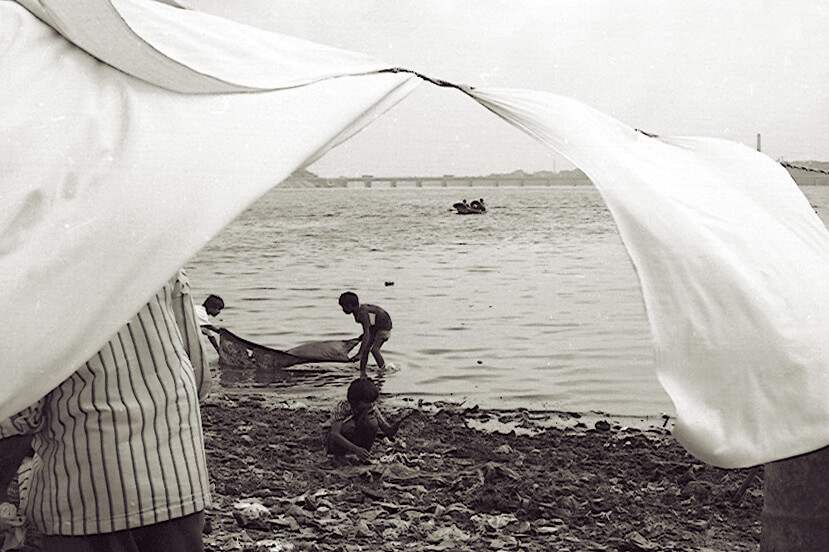
Photo: Seema Krishnakumar/ Creative Commons
The pollution problem
The riverfront project did not adequately address the pollution problem, and in the decade, it has been seen that pollutants were merely pushed downstream. Ahmedabad generates more than 1,200 million litres a day of domestic waste, then there’s untreated or half-treated industrial waste and other sewage. This mix has wreaked havoc in the river’s water which is being used by farmers downstream for irrigation. Their produce finds its way back to markets in Ahmedabad – a full circle of pollution, as it were.
The first holistic survey of the quality of Sabarmati waters in 2011 had shown that the bio-oxygen demand (BOD) and chemical oxygen demand (COD) were many times higher than the permissible level laid down by the Gujarat Pollution Control Board, so also the pH level. Later, the GPCB itself admitted in the Gujarat High Court that most Common Effluent Treatment Plants (CETPs) did not perform to optimum levels which means effluents were being released into the Sabarmati.
“It has become a norm rather than an exception that the scores of chemicals, pharmaceuticals and textile dyeing units illegally divert either half-treated or untreated trade effluents into the civic sewage pipelines which are not built to carry toxic industrial waste,” points out environmental activist Rohit Prajapati who took the issue to Gujarat High Court and the Supreme Court, and is on the Joint Task Force constituted by the High Court in March 2019.
“The Sabarmati does not have fresh water when it enters Ahmedabad; the riverfront is merely a pool of polluted stagnant water while the downstream of the riverfront has been reduced to a channel carrying effluents from industries from Naroda, Odhav, Vatva, Narol and sewerage from Ahmedabad city,” the Task Force report pointed out.
A division bench of the High Court, of Justice JB Pardiwala and Justice Vaishnavi Nanavaty, took up the issue as a sou moto petition after a flurry of media reports and held hearings every fortnight since mid-2021. Justice Pardiwala, in December 2021, stated, “We are doomed and only some divine power can help. We have no divine powers…(but) we have the power of the pen.” He blasted the GPCB officials: “You have created an irreversible situation.”
The bench asked the AMC to continue its drive against industrial units polluting the Sabarmati and asserted, “if there are any threats or pressures from politicians, report to the court…Nobody will touch you” and asked it to disconnect all illegal sewerage lines taking effluents into the river. The AMC told the court that it had snapped 263 out of 452 illegal connections.
Prajapati informed the court that as CETP authorities were not implementing the rules and norms it had framed, the river stretch near Vishala had zero-level oxygen. The court came down hard on the GPCB and CETP operators, and asked for revocation of bank guarantees of the polluting units. It also pointed to a critical aspect: That most owners of the polluting factories did not live in the vicinity so they would not realise the suffering of people who lived near the river, stakeholders who are off the radar when large “development” projects are planned and executed.
This is not all. The AMC has 14 domestic sewage treatment plants (STPs) of which only three were functional at the time of the hearings. Also, though only seven outfalls are permitted in the river, many more were found. All industrial units were mandated to show fresh samples and get new permissions to discharge effluents. The court’s amicus curiae Hemang Shah stated that the pollution level was so high that “one can’t even stand for a minute at the place”.
The Task Force found the Total Dissolved Solids (TDS) and Biochemical Oxygen Demand (BOD) at the river’s downstream were nine times and 150 times higher respectively than the prescribed limit. Justice Pardiwala connected the pollution to the riverfront: “It is painful that powerful people sitting on the top are protecting industrialists polluting the river…When we are taking pride of the Sabarmati riverfront, how can we spare those polluting the river?”
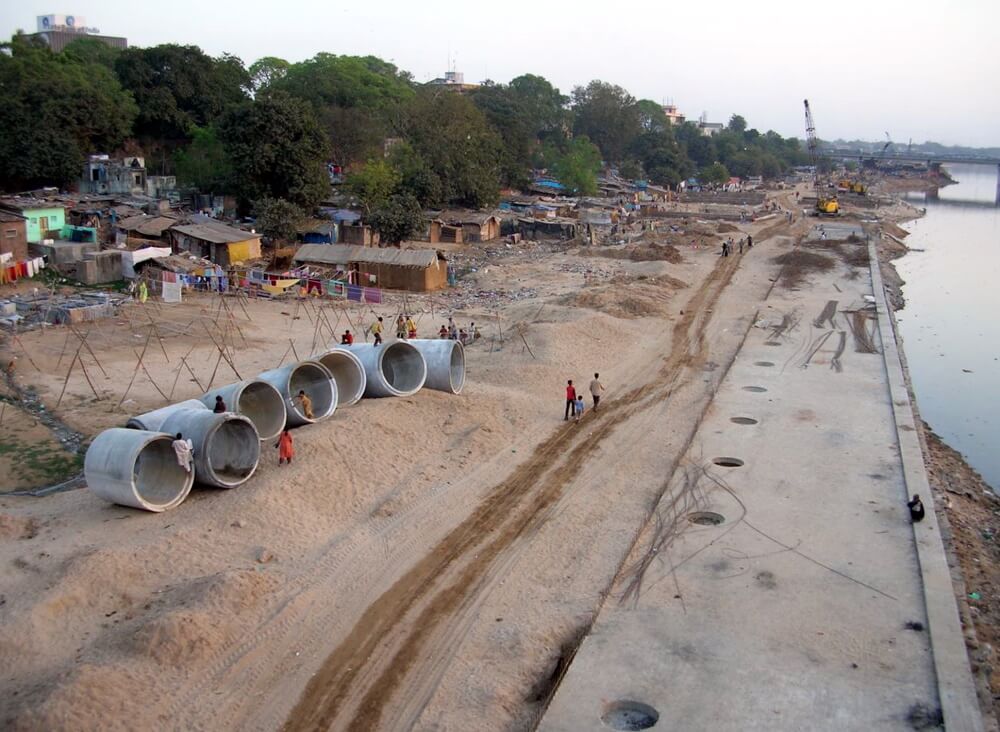
Photo credit: via Darshan Desai
The dressing up
In a sense, the constructed order and glamour of the riverfront has masked the severe problems of the river, both along the riverfront stretch and beyond it too. The river has run virtually dry in the riverfront stretch and has stagnant water brought from the Narmada, and is filled with industrial effluents and sewage in the downstream after the riverfront.
The report of the Task Force stated, “The drought-like condition of the Sabarmati River, intensified by the riverfront development, has resulted in poor groundwater recharge and increased dependency on the already ailing Narmada River.”
Sabarmati’s condition must force those in government as well as citizens to ask: What has the riverfront achieved? An honest answer would be that it has done little or nothing at all for Sabarmati River itself; it has, at best, created real estate and leisure spaces clearly meant for a rarefied section of Ahmedabad’s population.
This should not come as a surprise given that the project lead by Bimal Patel had stated back then that “of the total reclaimed land, Sabarmati Riverfront Development Corporation plans to sell 21 per cent for residential and commercial purposes…The rest of the land will be used to set up promenades, informal markets, gardens, and to extend the road network with 10 per cent to rehabilitate slum dwellers.”
The removal of slums, as if they do not house people, was in fact a stated objective of the project. The feasibility report had stated that nearly 10,000 families lived on the Sabarmati banks but only around 4,400 were eligible for rehabilitation. A study by the International Institute for Social Entrepreneurship Management, Mumbai, later showed the number of slum households along the riverbank to be 14,555.
Activists working with the riverfront dwellers’ associations have repeatedly said that these are all underestimates and thousands have been left to their own devices, though project officials decline this. It is evident that the riverfront project has done little, actually brought no relief at all, to all the displaced.
Public or private space?
International consultants have hailed the Sabarmati riverfront project as “a project towards urban regeneration and environmental improvement” and included it among the world’s most innovative urban projects. How innovative is it really to turn a small stretch of a non-perennial river, which runs dry many months and flows many metres wide during the monsoon, into a leisure and recreation space without comprehensively addressing its core problems?
Besides, the public-private space binary is open to question. “The riverfront as a landmark has been implemented as a homogenous, culturally unidentifiable feature, for which the project design team called on the embankments of the Seine as inspiration…Interviewees commenting on the lived experience of the riverfront describe reduced physical and visual access to the river…We also found that much of the new public space is currently privately managed and therefore essentially out of bounds,” found this research paper[2]
The official version is that the riverfront development has reduced erosion in the river and floods, the installed interceptor sewer lines and news pumping stations on the reclaimed banks have reduced pollution in the river, and the river is cleaned by use of machines.
Development over ecology
The second phase of Sabarmati riverfront development is scheduled to be completed by 2027. This phase of construction along its banks would add 5.8 kilometres to the existing 11.5-km stretch on the eastern side of the riverfront and 5.2 kms to the existing 11.5 km stretch on the western side. Once the second phase is completed, the total length of the riverfront would increase from 23 kilometres to 34 kilometres.[3] The second phase is expected to give a boost to the economic potential of the city.
To expand the riverfront project without taking an honest assessment of the first phase, which by most parameters has not served Sabarmati River well, is imprudent. Yet, that is what is happening on the ground and in the offices that drive this project on public finance. The first phase has already cost around Rs 1,400 crore.
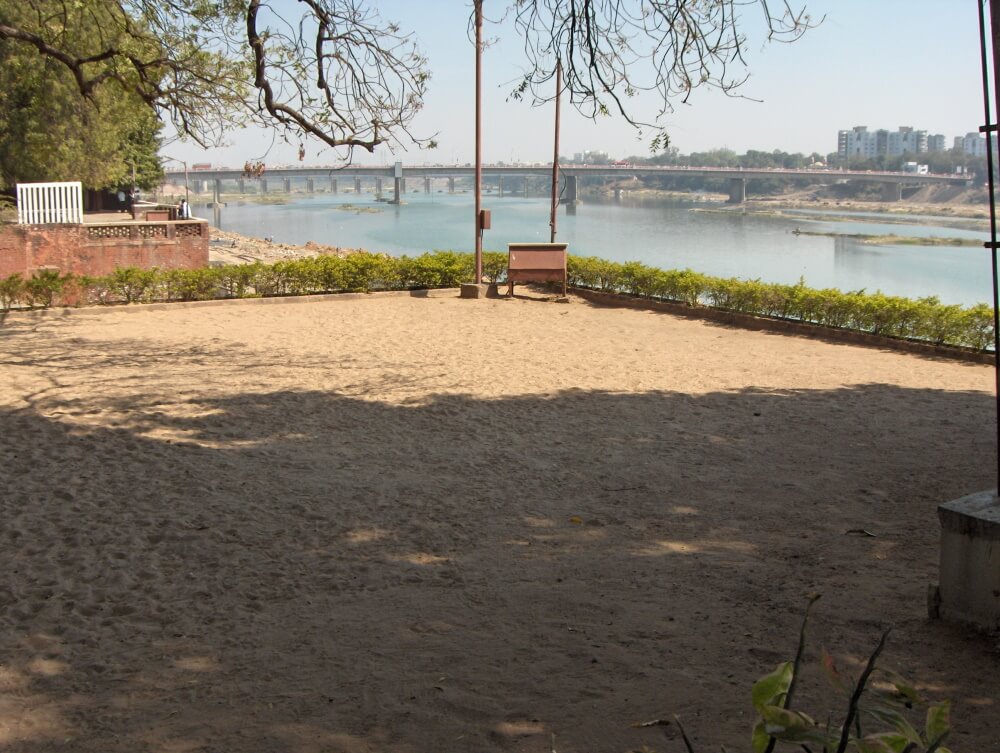
Photo credit: Nichalp/ Creative Commons
This approach of harnessing the river for the use of the city’s commerce is age-old but holds a particular irony in modern India – rivers passing through a city are bent and engineered purely for the city’s gain from the perspective of seeing the rivers as natural resources meant to be exploited, whereas rivers that define or support urban centres should be integrated into the city’s plan as natural resources to be conserved.
The former happens because, as researcher and writer Amita Baviskar, author of In the Belly of the River, says the popular articulation of an urban river is as a “non-place.” Once it is framed as a non-place, its complex ecosystem and the people it supports are made invisible or drowned out in the process of “developing” or “beautifying” it. Any voice arguing for the river’s ecology and a fair deal to people on river banks is framed as “anti-development” or an obstacle in the grand plan.
Urban planners imagine the river “as an assemblage of tubes and pipes with commodified openings for leisure and entertainment, not as seasonal ecological systems with floodplains as an integral part of its flows,” she wrote. In 2017, Baviskar told the London School of Economics, “Cities have gained water at the expense of the countryside, most blatantly I think in the case of the Sardar Sarovar dam…the irony is that the river Sabarmati is now flowing with water in Ahmedabad not because the Sabarmati has been unexpectedly rejuvenated, but because water from the Narmada has been transferred there. Riverfront development, water for cities which includes not just water for drinking and domestic use, but also water for industry and entertainment, these ‘non-basic’ uses of water have tended to get met because they happen to be in cities.”[3]
The fight for the Sabarmati is far from over, believes Prajapati. Indeed, so. Court cases, on-ground campaigns, awareness-building programmes and more will have to be mounted especially as the Sabarmati riverfront model is being adopted across the country.
Darshan Desai, a veteran Ahmedabad-based journalist, is currently the editor of Development News Network (DNN). He has written extensively on politics and policy in Gujarat and Uttar Pradesh for over 35 years.
Cover photo: Hardik Jadeja/Creative Commons

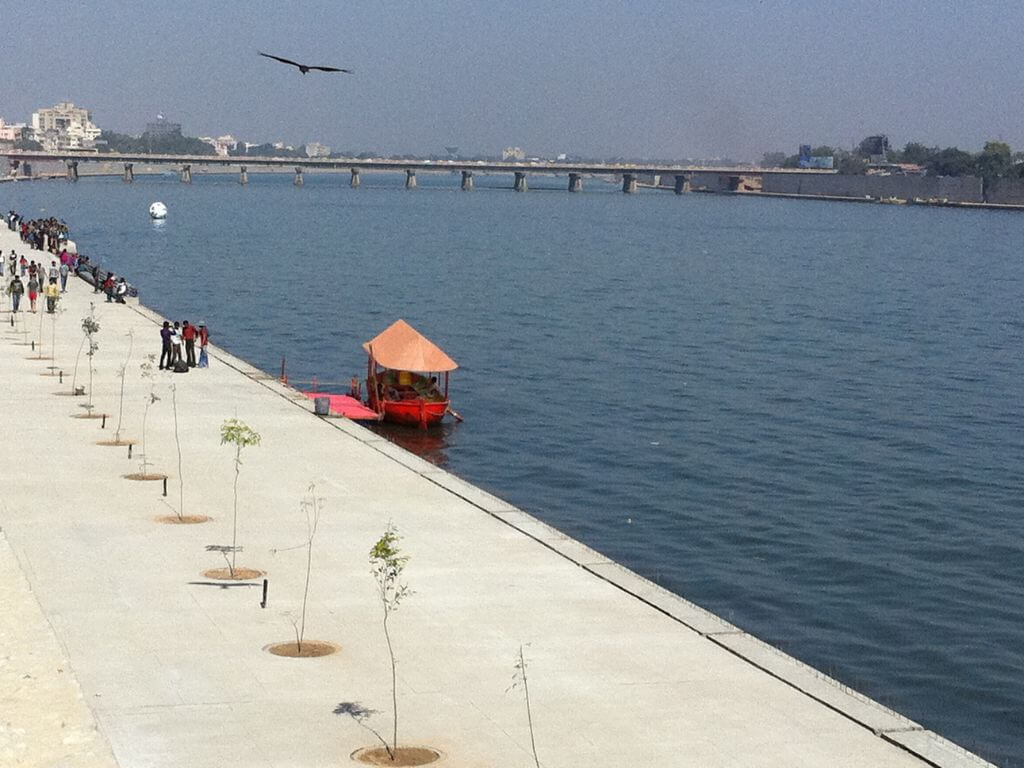
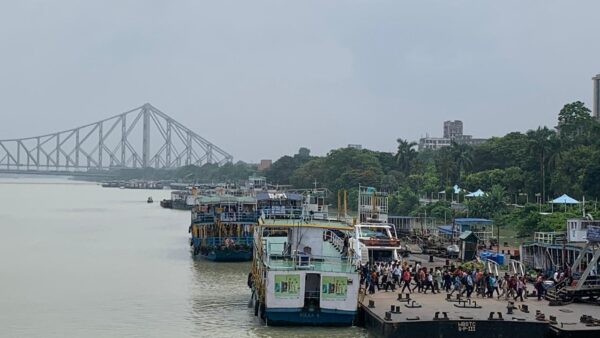
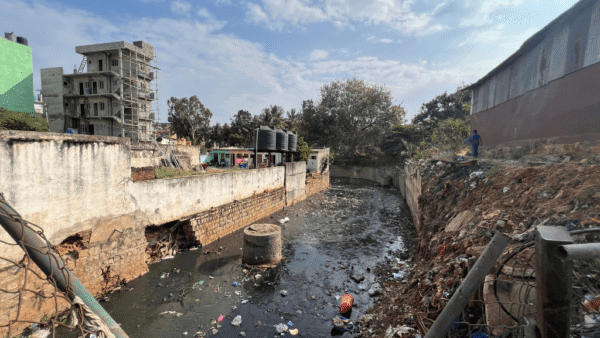
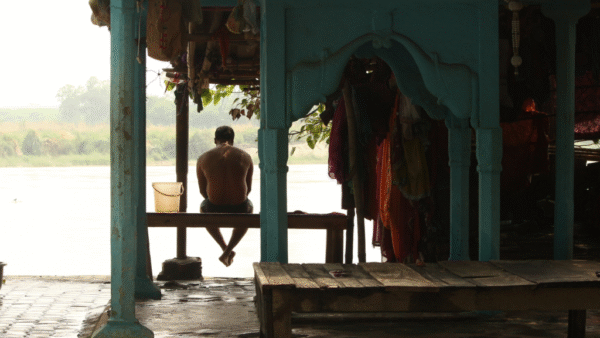
There is 1 comment
‘Sabarmati Riverfront is a travesty of my original plan’
Thank you for the story on the Sabarmati Riverfront project. As rightly stated in the article, I was the one who had proposed the Sabarmati riverfront development but not in this way. It was to be a part of a 400- kilometre ecological river valley keeping the natural sloped edges of the river intact to keep the Sabarmati’s water flowing, sometimes narrow and at other times wider, all regulated by the downstream barrage.
The project was not this walled- in corseted concrete sides that have been foolishly made now. What has been done is a travesty of my ecological and people oriented proposal, which has been made a predominantly economic one and this, in the long term, will end up privatising the river. It is already made somewhat inaccessible by having to cross large arteries now.
This is not only about solving the pollution problem. That is easy – just open the gates of the barrage and let 60 per cent of the trapped water out, it will help to reclaim some of the sandy slopes too and allow for agricultural or sport activities. The riverfront has to be seen in the larger ecological context.
I thank the author for the facts and the arguments he has brought out and hope that this will open doors for an appraisal and a larger discussion.
Bernard Kohn
(Living now in southern France and still fighting the riverfront development)